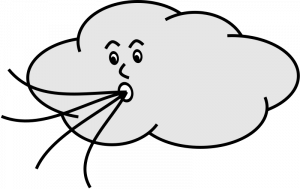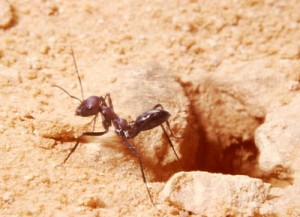All organisms cannot survive without food. Food is the substance that provides nutritional support to our body and is the form of energy that is essential for everyday function. But, how do we find food? The answer is simple: we open our pantry and select from the endless options of cereal boxes or drive to the nearest McDonalds and order from the dollar menu. The ability to search for food is a skill that humans take for granted. However, not all organisms can find food this easily.
An example of an organism that uses a complex sensory mechanism to forage for food is the Desert Ant (Cataglyphis fortis). The desert ant lives in the dry and very hot temperatures of the Saharan desert and is one of the most-heat tolerant groups of insects known. Because the ant can tolerate the heat, it is able to forage on the corpses of insects and other arthropods that died from the heat. The desert ant is known to leave their nest and travel over 1,000 meters in search of food. There has been evidence to suggest that the desert ant is able to find its way back home by using path integration. Path integration is ability to take measurements of its angle in respect with the Sun. The desert ant uses this angle to navigate back to its nest in the quickest time possible. But before the ant can travel home, how does it locate these corpses of insects for food?
The current study by Buehlmann et al. (2014) discovered that desert ants use their highly specialized olfactory system paired with the wind to locate their food. Ants are able to find odor plumes by moving crosswind. Crosswind movement is the ant’s ability to move perpendicular to the wind. The results showed that ants adopt their directional movement close to the crosswind instead of searching randomly for food. This idea that the wind is communicating to the ant and this helps the ant locate the odor plumes and eventually lead to food is so fascinating! The combination of food odors with crosswind movement allows the ant to find food efficiently and reduce the time spent foraging.
Another question the study addressed was: what chemical compounds of food odors facilitated a faster response in foraging behavior? The researches discovered that the desert ant is highly sensitive to the necromone, linoleic acid. Necromones are fatty acids that are present in the cuticles of insects and this specific compound (linoleic acid) plays a key role in food detection. This suggests that linoleic acid can withstand very hot conditions in the ant’s environment and may be detected by other organisms besides ants.

Figure 4 shows that ants were highly sensitive to linoleic acid, even at low doses (a, b, c, d)
Desert ants have it all! They locate their food quickly and efficiently using food odors such as the necromone linoleic acid paired with moving crosswind. They also make it back to their nest using path integration, right before a lizard eats them. However, the next question to explore in sensory ecology is which system plays a critical role in finding food for the desert ants: olfactory information or pathway integration? For now we can conclude that the ability to find food accurately allows the desert ants to limit their exposure to the Saharan sun, and have an adequate amount of energy for survival in their brutally hot environment.
If you would like to read this article you can find it on the website for Current Biology.
References: Buehlmann, C., Graham, P., Hansson, B.S., Knaden, M. (2014). Desert Ants Locate Food by Combining High Sensitivity to Food Odors with Extensive Crosswind Runs. Curr. Biol., 24, 960-964




what kind of food that it eat?